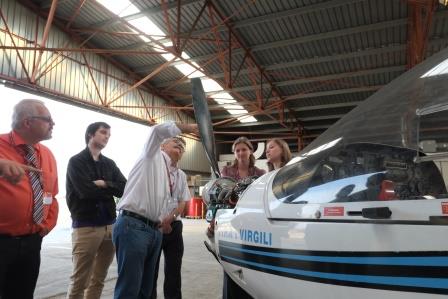06/06/2014
The URV patents an optical sensor that can be installed on aeroplane wings to detect the build-up of ice
The JEDI-ACE project (Japanese-European De-Icing Aircraft Collaborative Exploration) is a joint R+D programme between Europe and Japan that studies how to detect, prevent and eliminate the build-up of ice on certain parts of aircraft.

The JEDI-ACE project (Japanese-European De-Icing Aircraft Collaborative Exploration) is a joint R+D programme between Europe and Japan that studies how to detect, prevent and eliminate the build-up of ice on certain parts of aircraft.
The European and Japanese partners in the project have met at the Universitat Rovira i Virgili to discuss the advances made in the research. During their time at the URV, they also visited the Centre for Advanced Aviation Studies (CESDA), which is also collaborating in this project.
The new optical sensor has been developed by the Physics and Crystallography of Materials research group (FiCMA) and has already been patented by the URV. The final modifications are being made to the first prototype, which uses fibre optics to detect the build-up of ice on aeroplanes and any other type of machinery where this can be an issue. The sensors measure one millimetre across and are activated as soon as ice starts to form. The device does not affect the plane’s aerodynamics and can be fitted to the wings or to any other part of machine where the build-up of ice can pose a danger.
The sensor works in the following manner: an optical fibre carries infra-red light to the sensor, and another optical fibre receives this signal after it interacts with the air-water-ice system. By analysing the intensity of this signal, the sensor can tell if the light has interacted with air, water or ice. As soon as ice is detected, the sensor automatically heats the wing to thaw the ice. This enables the de-icing system to be activated without distracting the pilots.
Aircraft manufacturers have yet to develop sufficiently accurate and reliable ice-sensors that can be automated. It is therefore ultimately up to the pilot to decide if there is a danger from the build-up of ice and, if necessary, to manually activate the de-icing systems. Doing so reduces danger and inefficient fuel consumption caused by the build-up of undetected ice, which also increases the weight of the plane and affects its aerodynamics.
The sensor has received interest from over ten companies operating in ambits a diverse as the aeronautical industry, wind power, the pharmaceutical industry and the food industry.
The sensor is one of the advances that was presented during the meeting between the various partners in the JEDI-ACE project at the Universitat Rovira i Virgili and CESDA.
The European partners are the German Fraunhofer Institute, the French company Dassault- Aviation and the URV. The Japanese partners are Kanagawa Institute of Technology (KAIT), the Japanese Space Agency (JAXA) and Fuji Heavy Industries (FHI-Subaru).
The project coordinator at the URV is Doctor Francesc Díaz from the FiCMA research group. The other members of the group participating in the project are Doctor Magdalena Aguiló, Doctor Airán Ródenas and the doctoral student Javier Martínez. The group has been working in conjunction with Doctor Miquel Traveria of CESDA to develop the project.
This project has a budget of four million euros, half of which is provided by the EU’s seventh framework programme and the half by the Japanese government. The URV will have received 600,000 euros by the time the three-year research project ends in 2015.
More news about: Ace, Aeroplane wings, CESDA, FiCMA, JEDI-ACE, Sensor
